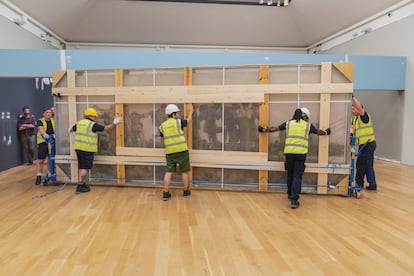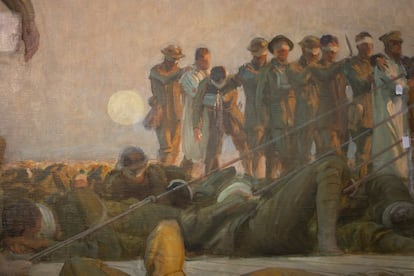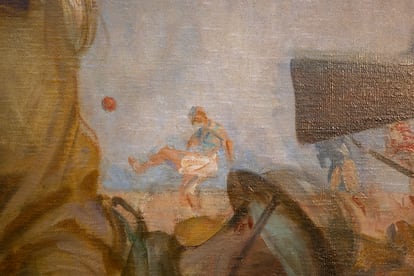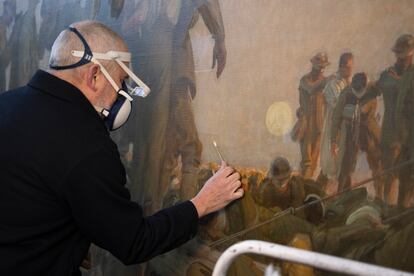‘Gassed,’ by Singer Sargent: the restoration of a masterpiece to narrate contemporary war
The Imperial War Museum in London has made the canvas the centerpiece of its new gallery. The restoration has allowed for the discovery of new colors and greater depth within the work

Near the end of World War I, John Singer Sargent came across a group of soldiers. Victims of mustard gas, they were blinded by bandages, which tried to relieve the unbearable pain in their eyes. Resting their arms on the shoulders of their comrades, they marched in an orderly row of desolation. As he observed this, the painter found a new language to narrate the wars of the 20th century.
This past November, the Imperial War Museum in London opened the Blavatnik Art, Film and Photography Galleries, a space dedicated to how artists have documented several of the world’s armed conflicts. This permanent exhibition features Gassed (1919), by Singer Sargent. The painting is 20 feet long and seven feet tall. The museum’s conservators have spent two years recovering its depth, colors, details and multiple meanings.

Gassed is one of the paintings most revered by British art historians. It leaves behind the war paintings of the 19th century — which often glorified the victories of an empire on the verge of decline — to reveal the more human side of heroism. Gassed offers a raw depiction of sacrifice, loss, suffering, solidarity and hope, through the young men who advance, blindly, through the embers of an absurd global conflict.
“During World War I, the task assigned to artists was very different. They were hired to record the war experience in their work,” explains Rebecca Newell, director of art at the Imperial War Museum. She supervised the restoration of Singer Sargent’s masterpiece. “There’s a clear desire to show respect to these men. The aim isn’t to glorify them, but rather to highlight their sacrifice. It’s an attempt to show reality as it is,” she points out, in an interview with EL PAÍS.
The challenge of depicting war
In 1918, the painter was 62 years old. He had made a name (and a fortune) for himself with his wonderful portraits of the British aristocracy and the emerging American bourgeoisie. The end of World War I wasn’t the best time to take artistic risks. Still, his fame and prestige made Singer Sargent a key player in the British government’s efforts to tell the story of a war that was changing much of the world. Prime Minister David Lloyd George personally wrote to the artist, asking that he contribute to the work of the British War Memorials Committee. The piece that Singer Sargent would ultimately create would be at the center of a new space, meant to record the years of pain and effort in the national memory.
Although the committee’s hired painters and sculptors were given freedom to create, certain motifs of inspiration were suggested. Singer Sargent — the son of wealthy Americans, art lovers and nomads, who moved their children around Europe for years — was asked by the British government to reflect the Anglo-American partnership on his canvas.
In search of ideas, the painter left for the French and Belgian frontlines in July of 1918, accompanied by Henry Tonks, his friend and fellow painter. Singer Sargent wanted to create an epic worthy of the assignment he received. However, as he advanced towards the front, he only found ruins, shrapnel, dirt, long waits and boring days. In short, the mediocrity and disappointment that the writer Robert Graves narrated with such precision in Goodbye to All That (1929), the canonical work about the First World War.
But on August 21, 1918, inspiration stuck. In a letter to Alfred Yockney, the secretary of the committee, Yonks wrote about how, one afternoon, while he and Singer Sargent were having tea in Doullens, France, they were told that a group of young men were being treated at the nearby Bac-du-Sud field hospital. The soldiers had been the victims of poison gas. Today, in the same place where they were treated in northwestern France, a cemetery for British servicemen has been built.
World War I introduced a dirty, terrifying and unfair new weapon: poison gas. Chlorine gas attacked the lungs and suffocated people, while phosgene — colorless and odorless — was even more lethal and treacherous, with its effects taking up to 24 hours to hit. And then, there was the terrible mustard gas, which destroyed the lungs and burned the skin, until it broke out into a multitude of blisters.
The soldiers, in their naivety, thought that they could dodge shrapnel, or that their bodies could resist the impact of bullets. But fear paralyzed them when the gong sounded, warning of a toxic attack. The gas advanced like ectoplasm and threatened unbearable suffering.
“The gassed men kept arriving in groups of six. They were directed in an orderly manner, as [Singer Sargent] portrayed them. They sat or lay down on the grass. There were several hundred of them [in total]. It was evident how much they were suffering,” Tonks wrote in his letter. “Their eyes [were especially harmed], they were covered with gauze… [Singer Sargent] was shocked by the scene and immediately began to take notice and create sketches.”
In the painting, nine blindfolded soldiers, wary and defeated, walk in a line. Each one clings to the shoulders of the man in front of him. One turns his back to the observer, to vomit. Another raises his right leg, for fear of tripping on a step of uncertain height. A nurse directs them along a wooden walkway towards the field hospital tent.
In the background, to the right — accompanied by an immense moon in a pink sunset — another group of gassed men advances in the same direction. One of them is also vomiting. And, further in the background, soldiers in red and blue shirts play a game of soccer.

“We see a certain order. We see uniforms for each of the teams. There’s order, not chaos. In the image, we can see the contrast between the suffering of some and the health of others. Young people whose lives have been cut short at the best moment, while others move on,” Newell suggests, while looking at the painting. “But we can also see the image of routine in contemporary war, where a soccer match goes ahead, despite everything that is happening. A tremendous scene of suffering, [with the] added background of everyday life.”

In the 1970s, museum officials applied a layer of varnish to preserve the painting, which was visited and adored by thousands of people. In a darker work, the protective layer of yellow would have gone unnoticed. But in Sargent’s canvas — where each detail takes on a unique meaning — yellow took over the composition. Subsequent generations wanted to see the uniform and lethal tone of mustard gas in the flat dimensions of a colorless work.
“As little by little the layers of varnish were removed, a revelation emerged. I began to see the pinks, yellows and greens of the sky emerging, subtle and soft. [This is] reminiscent of Sargent’s previous work with Monet,” says chief conservator Phil Young. “And the soft profile of the soldiers against the sunset, almost with their own light, became more apparent. The three-dimensionality of the work — including the soccer players in the distance — was discovered,” he explains.

The image of war
Gassed was exhibited at the Royal Academy of Arts, in the Summer Exhibition of 1919. It was the centerpiece, at a time when the use of art in the service of the nation was being debated.
There were doubts about so much sentimentality. Virginia Woolf’s criticism of the painting was devastating: the image of the soldier raising his leg before the uncertain step especially irritated her. “This little piece of over-emphasis was the final scratch of the surgeon’s knife,” she wrote, in an article for The Athenaeum magazine. “In order to emphasise his point that the soldiers wearing bandages round their eyes cannot see, and therefore claim our compassion, he makes one of them raise his leg to the level of his elbow.”
“And yet,” Newell refutes, “when the public was able to see [the painting], many of the war veterans — who would have suffered from gas attacks — said: ‘That’s exactly what happened. It was chaotic, clumsy, with false steps. It was difficult to orient yourself. The victims were scattered on the ground.’”
The British don’t have their Guernica, to reflect the atrocity and devastation of war. Nor do they have a May Day, by Diego Rivera, to glorify defeat. Instead, they have Singer Sargent’s Gassed, which celebrates the pain and promise of redemption of World War I, which claimed an entire generation of young men.
Sign up for our weekly newsletter to get more English-language news coverage from EL PAÍS USA Edition
Tu suscripción se está usando en otro dispositivo
¿Quieres añadir otro usuario a tu suscripción?
Si continúas leyendo en este dispositivo, no se podrá leer en el otro.
FlechaTu suscripción se está usando en otro dispositivo y solo puedes acceder a EL PAÍS desde un dispositivo a la vez.
Si quieres compartir tu cuenta, cambia tu suscripción a la modalidad Premium, así podrás añadir otro usuario. Cada uno accederá con su propia cuenta de email, lo que os permitirá personalizar vuestra experiencia en EL PAÍS.
¿Tienes una suscripción de empresa? Accede aquí para contratar más cuentas.
En el caso de no saber quién está usando tu cuenta, te recomendamos cambiar tu contraseña aquí.
Si decides continuar compartiendo tu cuenta, este mensaje se mostrará en tu dispositivo y en el de la otra persona que está usando tu cuenta de forma indefinida, afectando a tu experiencia de lectura. Puedes consultar aquí los términos y condiciones de la suscripción digital.
More information
Archived In
Últimas noticias
Maduro pleads not guilty before the federal court in New York: ‘I am still the president of Venezuela’
A new test can detect Alzheimer’s from a finger prick
UN team enters Sudanese city of El Fasher after paramilitary massacre: ‘It’s like a ghost town’
A recipe for resistance: Indigenous peoples politicize their struggles from the kitchen
Most viewed
- Gilles Lipovetsky: ‘If you want to live better and fall in love, take Prozac, don’t look to philosophy’
- Alain Aspect, Nobel laureate in physics: ‘Einstein was so smart that he would have had to recognize quantum entanglement’
- Alvin Hellerstein, a 92-year-old judge appointed by Bill Clinton, to preside over Maduro’s trial in New York
- Why oil has been at the center of Venezuela-US conflicts for decades
- Maduro’s downfall puts China’s relationship with Venezuela to the test











































